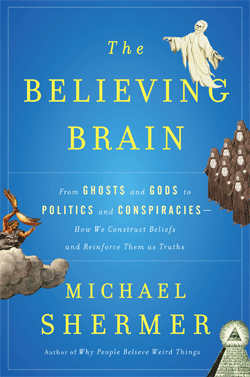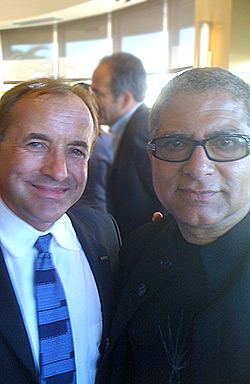by
Michael Shermer, Jul 26 2011

When I was in a psychology graduate program in the late 1970s, the nature v. nurture debate was in full-throated either-or mode, with crudely conceived experiments and data sets marshaled to defend one side or the other, as if asking whether π or r2 is more important in calculating the area of a circle. (Thankfully this debate today has morphed into much more sophisticated research by behavioral geneticists and others to understand how nature and nurture interact, well summarized in Steven Pinker’s The Blank Slate and Matt Ridley’s Nature via Nurture.) In addition to the studies examining twins separated at birth and raised in separate environments, I recall that raising chimpanzees in a human environment and trying to teach them sign language garnered considerable media attention as pioneering research into understanding the nature of human (and primate) nature, along with language and cognition. These were heady times of bold experimentation, the most prominent being Project Nim, initiated and monitored by Columbia University psychologist Herbert Terrace. Terrace in particular wanted to test MIT linguist Noam Chomsky’s then controversial theory that there is an inherited universal grammar that is the basis to language and unique to humans, by teaching our closest primate cousin American Sign Language (ASL). Terrace, however, did a turnabout, concluding that the signs Nim Chimpsky (a cheeky nod to Noam Chomsky) learned from his human companions and trainers amounted to little more than animal begging, more sophisticated perhaps than Skinner’s rats and pigeons pressing bars and pecking keys, but in principle not so different from what dogs and cats do to beg for food, be let outside, etc.—a “Clever Hans” effect in primates. His 1979 book, Nim, outlines the project and his assessment of its results. There have been many evaluations and critiques since that time, most recently by Elizabeth Hess in her 2008 book, Nim Chimpsky: The Chimp Who Would Be Human (Bantam Books), which is the basis of the new documentary film, Project Nim, by James Marsh (whose previous film, Man on Wire, is portrays the tightrope walker Philippe Petit). Continue reading…
comments (23)
by
Michael Shermer, Jun 28 2011
An attempted ambush interview turns
into a lesson in patternicity and numerology
On Friday, June 17, a film crew came by the Skeptics Society office to interview me for a documentary that I was told was on arguments for and against God. The producer of the film, Alan Shaikhin, sent me the following email, which I reprint here in its entirety so that readers can see that there is not a hint of what was to come in what turned out to be an attempted ambush interview with me about Islam, the Quran, and the number 19:
Dear Michael!
I am the director of a film crew hired by a non-profit organization, Izgi Amal, from Kazakhstan, which has no connection with the American brat, Borat. We have been working on a documentary film on modern philosophical and scientific arguments for and against God for almost a year. We have been taking shots and interviewed theologians, philosophers and scientists in England, Netherlands, USA, Turkey, and Egypt.
We are planning to finish the film by the end of this year and participate in major film festivals, including Cannes. We will allocate some of the funds to distribute thousands of copies of the film for free, especially to libraries and colleges.
Our crew will once again visit the United States and will spend the rest of June interviewing various people, from layman to artists, from academicians to activists.
Though we are far out there, we know your work and we think that it contributes greatly to the quality of this perpetual philosophical debate. We would like to include perspective and voice in this discussion. We would appreciate if you let us know what days in JUNE would be the best dates to meet you and interview you for this engaging and fascinating documentary film.
Since we are planning to interview about 10 scholars and experts of diverse positions such as atheism, agnosticism, deism, monotheism, and polytheism, it is important to learn all available days in this month of June.
Please feel free to contact us via email or our cell phone numbers, below. If you respond via email and please let us know the best phone number and times to reach you.
Peace,
Alan Shaikhi
Continue reading…
comments (132)
by
Michael Shermer, May 31 2011
The following excerpt is from the Prologue to my new book, The Believing Brain: From Ghosts, Gods, and Aliens to Conspiracies, Economics, and Politics—How the Brain Constructs Beliefs and Reinforces Them as Truths. The Prologue is entitled “I Want to Believe.” The book synthesizes 30 years of research to answer the questions of how and why we believe what we do in all aspects of our lives, from our suspicions and superstitions to our politics, economics, and social beliefs. LEARN MORE about the book.
According to a 2009 Harris Poll of 2,303 adult Americans, when people are asked to “Please indicate for each one if you believe in it, or not,” the following results were revealing:1
-
82% believe in God
-
76% believe in miracles
-
75% believe in Heaven
-
73% believe in Jesus is God
or the Son of God
-
72% believe in angels
-
71% believe in survival
of the soul after death
-
70% believe in the
resurrection of Jesus Christ
-
61% believe in hell
-
61% believe in
the virgin birth (of Jesus)
-
60% believe in the devil
-
45% believe in Darwin’s
Theory of Evolution
-
42% believe in ghosts
-
40% believe in creationism
-
32% believe in UFOs
-
26% believe in astrology
-
23% believe in witches
-
20% believe in reincarnation
Wow. More people believe in angels and the devil than believe in the theory of evolution. That’s disturbing. And yet, such results should not surprise us as they match similar survey findings for belief in the paranormal conducted over the past several decades.2 And it is not just Americans. The percentages of Canadians and Britons who hold such beliefs are nearly identical to those of Americans.3 For example, a 2006 Readers Digest survey of 1,006 adult Britons reported that 43 percent said that they can read other people’s thoughts or have their thoughts read, more than half said that they have had a dream or premonition of an event that then occurred, more than two-thirds said they could feel when someone was looking at them, 26 percent said they had sensed when a loved-one was ill or in trouble, and 62 percent said that they could tell who was calling before they picked up the phone. In addition, a fifth said they had seen a ghost and nearly a third said they believe that Near-Death Experiences are evidence for an afterlife.4
Continue reading…
comments (42)
by
Michael Shermer, Apr 05 2011
On Thursday, March 31, Deepak Chopra and I squared off for a second time in person in a public venue, this time accompanied by the physicist Leonard Mlodinow on my side and Stuart Hameroff on his side (along with other panelists). The question on the table was this:
“Is there an Ultimate Reality?” and if yes, “Can it be accounted for by science such as mathematics, biology and physics?”
My answers: YES and YES
I explained that I am a Materialist and a Monist. I do not believe that there is a body and a soul, there is just a body. There is no brain and mind, just brain. The mind is just a word we use to describe what the brain does. I said, “you know I’m right” (which got a surprising laugh from the audience) because of the evidence from strokes, tumors, brain damage, senility, dementia, and Alzheimer’s, all of which kill brain cells, and along with the loss of brain comes the loss of mind. I asked Deepak and Stuart where Aunt Millie’s mind goes when her brain slowly disappears from the effects of Alzheimer’s disease. Continue reading…
comments (67)
by
Michael Shermer, Jan 25 2011
TEDxCaltech Celebrates the Vision of Richard Feynman

On Friday, January 14, 2011, the spirit of TED (Technology, Entertainment, Design) was enacted as TEDxCaltech, one of many independent lecture series that have spontaneously emerged from the bottom up by what I call “ideas entrepreneurs,” creative individuals who want to change the world by spreading ideas in the format modeled after the annual event now held in Long Beach (albeit at a fraction of the cost: $85 versus $6000). The theme of TEDxCaltech was “Feynman’s Vision: The Next 50 Years,” celebrating Richard Feynman’s famous 1959 lecture, “There’s Plenty of Room at the Bottom,” which helped launch the field of nanotechnology. As Feynman said, “Our imagination is stretched to the utmost, not, as in fiction, to imagine things which are not really there, but just to comprehend those things which are there.”
Feynman was famous for telling stories, so first up on the morning program was Feynman’s daughter Michelle, who recounted what it was like to hear bedtime stories from her famous father. Michelle then introduced Christopher Sykes, the British documentary film maker who cast Feynman’s stories into filmic narrative in his famous film The Pleasure of Finding Things Out (the phrase inspired by a Feynman quip about why he does science—not to change the world or discover some grand unifying theory of everything, but just for the pleasure of finding things out). Sykes recounted how intimidating it was to initially approach the normally reclusive Feynman with the idea of sitting him down in front of a camera, but Feynman agreed, perhaps because he knew his life was coming to an end because of cancer, or perhaps because Sykes is such a warm and engaging man. Whatever the reason, the world is a better place with Feynman’s voice still engaging us two decades after his death (you can watch excerpts from the film on YouTube). Continue reading…
comments (6)
by
Michael Shermer, Jan 12 2011
The following is an op-ed originally published in the Los Angeles Times, Tuesday January 11, 2011 (under a different title and slightly shorter).
The media once again scrambled this past week to find the deep underlying causes of shocking events. We saw it in the rush to explain the tragic murder of six people in a shopping center in Tucson. And we saw it in the rush of stories about mass die offs of birds and fish around the country.
In the case of the shooting of Rep. Gabrielle Giffords at a shopping center in Tucson, attention has turned to the motives of the shooter, 22-year old Jared Loughner, whose political ramblings about returning to the gold standard and about excessive control by the government have sent the media searching for answers in the vitriol of right-wing talk radio, the rhetoric of the Tea Party movement, and the bellicose divide between Democrats and Republicans in Congress and elsewhere.
The mass die offs of fish and birds has spurred a number of deep causal theories, including suggestions that the apocalypse is near and that secret government experiments were to blame, such as HAARP, the High Frequency Active Auroral Research Program in Alaska that studies the ionosophere that is run by DARPA, the government’s Defense Advanced Research Projects Agency, which admittedly does sound like something concocted by the writers for the television series X-Files. Continue reading…
comments (123)
by
Brian Dunning, Jul 08 2010
When recreational mathematician Martin Gardner died earlier this year, he left us a huge number of books. One of these is called Fads & Fallacies in the Name of Science. In his first chapter, Gardner went into some depth on characterizing cranks. Cranks are folks whom I encounter quite frequently in my work on Skeptoid; not only from the side promoting pseudoscience, but also from the side of skeptics. I find that a few skeptics are little different methodologically from the pseudoscientists they so fervently argue against, and so I believe it’s of great value to everyone to familiarize himself with Gardner’s list.
My fellow blogger Michael Shermer wrote a column recently in Scientific American that discussed this in somewhat more detail, and if you’re not a subscriber, you can get his article online here. It rang quite true with me, so I wanted to take a look at Gardner’s thesis from the perspective of being a science outreach professional. Continue reading…
comments (27)
by
Brian Dunning, Jun 11 2009
So now to follow up on last week’s post about this alleged TV show that Michael Shermer and I were allegedly “guests” on. I was supposed to be the host and was giving some tests to three psychics, one of which turned out to be a character (“Shirley Ghostman”) of a UK comic named Marc Wootton, but of course I didn’t know that. For his final bit of zaniness, he channeled the spirit of actor Lee Majors who told of the afterlife (Lee Majors is not dead).
Later in the show, after “Shirley” had been “thrown out and escorted from the grounds” (so I believed), Michael and I were having our discussion, on camera, about my findings with the psychics. Suddenly the studio doors slammed open, and in ran Shirley, pushing a cart holding a bodybag! I knew that Shirley was unbalanced and belligerent, so I stood the hell back and expected that security was going to tackle him and get him out of there. No such thing happened. In fact, the film crew hardly reacted at all. Michael had not had my previous experience with Shirley, so he stepped up cheerfully and asked to see what was in the bag. After some tussling, they got it open, and there’s some guy with a desk calculator or something taped to his chest, and another to his arm: The Six Million Dollar Man. Shirley was right: Lee Majors had died, and here was the body to prove it. Continue reading…
comments (18)




